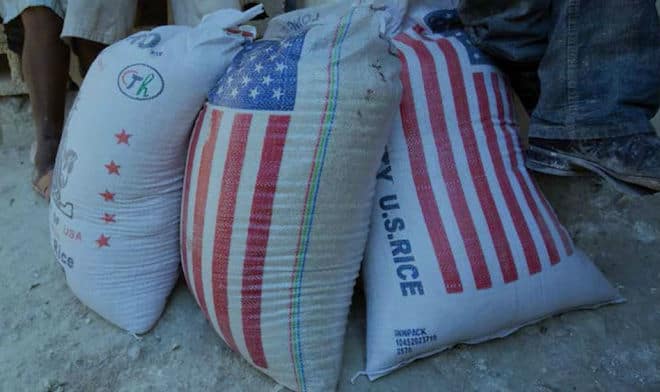Tucked away in Title III of the 2014 US Farm Bill, occupying just one of its 357 pages, quietly sits a reform that will empower thousands of farmers to feed millions more people a year suffering from hunger. Despite its practicality and comparatively low profile, it represents a long, hard fought victory. It’s an expansion of local purchasing of international food aid – and it’s worth celebrating.
Food aid is the backstop of our global food supply. When all else fails, it stands between life and mass starvation. With more than 850 million people suffering from hunger, efficiency in supporting their right to food matters. By using up to $80 million a year to buy food from local sources instead of distant American ones, the reform will feed millions more people. The concept is simple. For instance, if food aid was needed in Vietnam and rice was available in nearby Thailand, it could be purchased there instead of the current practice of shipping it from the US.
This process, proven by other food aid donors and a US pilot project:
- Cuts food and delivery costs by 25-50%;
- Reduces the average time it takes to deliver food by 14 weeks;
- Reaches more people at a lower cost;
- And, can have longer-term benefit of investing in farmers abroad, making them better able to support their own communities.
Despite all this, even small steps toward permitting local purchasing have been bitterly opposed by special interests, including agribusinesses and shippers. They cling to an antiquated status quo that requires all food to come from the United States. This made some sense when established in the 1950s, when my grandparents were farming in Minnesota. America had a surplus of cheap commodities and food aid was difficult to procure elsewhere. This hasn’t been true for a long time.
The old regime isn’t even particularly profitable for those who defend it, and they know it. In a hilarious Daily Show segment, a shipping industry representative repeatedly cites “heritage” as reason to maintain obsolete regulations. A Farm Bureau economist told Reuters she was more concerned with a loss of “pride” than farm revenue. Food aid amounts to about one percent of US agricultural exports – not enough to measurably impact commodity prices. My grandparents would have been proud to sell that fraction of their crop elsewhere in order to support fellow farmers abroad.
It’s taken common-sense sentiments like that, pushed in a sustained effort over years to achieve this victory. A coalition of organizations, including American Jewish World Service, Bread for the World, CARE, Catholic Relief Services, Mercy Corps, Oxfam America, and others have helped lead the charge. Champions on Capitol Hill have seen it through. The tragic case of Typhoon Haiyan’s impact in the Philippines and resulting outcry for change emboldened advocates as the Farm Bill went to conference committee. This win is a big, lifesaving step forward.
However, local food aid procurement remains the exception to the rule. If fully funded, the new reform would account for about 5 percent of total food aid activities authorized under the Farm Bill. The best approach is to remove the straightjacket and allow the US Agency for International Development (USAID) to choose the best way to procure food based on individual circumstances. By doing so, an estimated 17 million more people could receive food aid at no extra cost. There is no one-size-fits-all method (see USAID’s great infographics here), and there will always be a need for some commodities grown in the US, but experts should make the call for each situation free of legislative constraints.
We came close to ending more of those restraints last year. President Obama proposed sweeping reform to allow food aid to be purchased locally. Another proposal, offered as a Farm Bill amendment by Representatives Royce and Engel, failed by only 17 votes. If just nine members had voted differently, the amendment would have prevailed. The vote was remarkably bipartisan – the issue always has been. In fact, the Bush administration unsuccessfully called for reform. Local purchasing of food aid is something everyone can get behind.
2014 is the year to do it. We expect the Obama administration to continue to push for reform. Budgetary pressures aren’t letting up, mandating the kind of cost efficiencies local purchasing delivers. The need for food aid seems set grow in the short-term; the increasing threat of climate disasters and manmade disasters, like the plight of Syrian refugees, demand a more responsible approach.
2014 is also the International Year of the Family Farmer. What a great time to allow more farmers to respond to food emergencies and break cycles of aid dependency through a more flexible food aid system. Reform in the 2014 Farm Bill, while an important victory unto itself, has given us the momentum to do even better.

These farmers in Bolivia could help to efficiently respond to nearby food emergencies. (Peter Tecks / Oxfam)
Sign up for Food Tank’s FREE Weekly Newsletter. More than 110,000 Subscribers And Counting. Click HERE to join.












